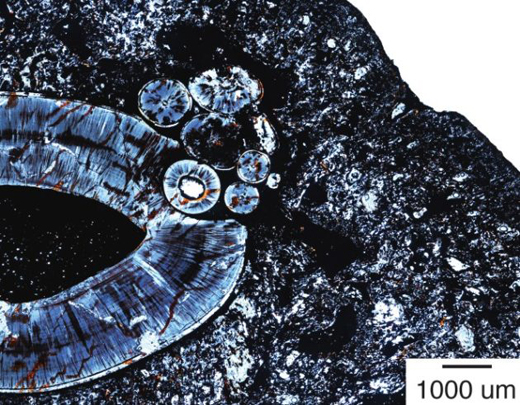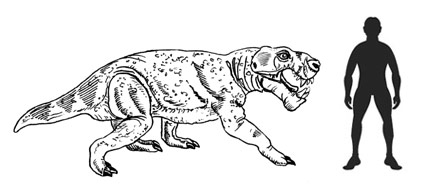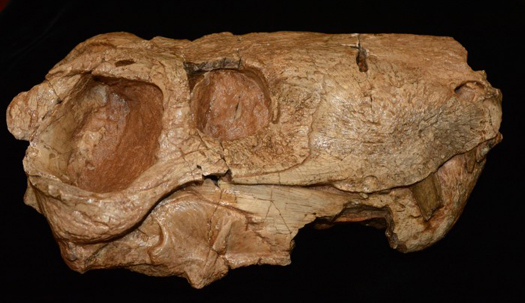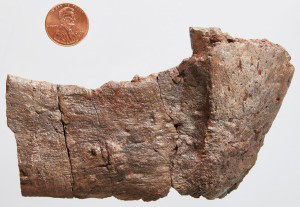Tumour Discovered in 255 Million-Year-Old Monster as New Research is Published
Gorgonopsid with Compound Odontoma
Researchers at the University of Washington have discovered evidence of a benign tumour in the fossilised lower jaw of a Late Permian predator, a gorgonopsid. Thin sections of bone examined under the microscope reveal that this distant relative of modern mammals was suffering from a compound odontoma. Scientists are studying the fossils of “mammal-like reptiles”, in a bid to learn more about how common diseases in mammals first evolved.
Fragment of Jaw
The fragment of jawbone was found by Professor Christian Sidor (University of Washington and curator of vertebrate palaeontology at the Burke Museum of Natural History and Culture), whilst on a field trip to the Late Permian beds of Tanzania. The fossil was identified as belonging to a member of the Gorgonopsidae, a diverse group of Permian therapsids that evolved around 260 million years ago and ranged widely across the super-continent of Pangaea.
Although early gorgonopsids were small, some no bigger than a terrier, later gorgonopsids evolved into apex predators. As members of the Therapsidae, they belong on the same branch as the vertebrate family tree as the mammals, although there is still much debate as to how closely related gorgonopsids are to extant mammals.
A Typical Late Permian Gorgonopsid – Inostranvecia alexandri
Picture credit: Everything Dinosaur
Models and replicas of gorgonopsids are quite rare, but collectors and fans of prehistoric animals can pick one up from Everything Dinosaur. Safari Ltd added a model of the gorgonopsid Inostrancevia to their Wild Safari Prehistoric Life range in 2011, to view this product range: Wild Safari Prehistoric World Models.
A Compound Odontoma
In a letter published in the Journal of the American Medical Association Oncology, the research team report on the evidence that an animal that lived in Africa some 255 million years ago, had a small, benign tumour within its lower jaw.
The tumour has been identified as a compound odontoma, essentially, an abnormal growth in the jaw in which clusters of tooth-like structures complete with enamel, dentine and cementum form. They are quite common in mammals and can affect our own species. Although benign, most people have them removed as their growth and encroachment into other tissues and bone can cause considerable pain.
Senior author Professor Sidor stated:
“We think this is by far the oldest known instance of a compound odontoma. It would indicate that this is an ancient type of tumour.”
Other odontomas have been found in the fossilised remains of mammals before, but as far as Everything Dinosaur team members are aware, all these fossils are associated with Quaternary deposits and thus, the fossils come from mammals that lived much more recently.
A Lateral View of the Skull of a Typical Gorgonopsid
Picture credit: Professor Sidor/University of Washington
Tracing the Origins of Pathology within the Mammalia
Finding evidence in an ancient jawbone suggests that the causes of odontoma in the Mammalia are nested deep within the ancestral roots of this Class of vertebrates. The fragment of lower jaw was found in isolation, this single fossil was not found in association with other material, so its scientific value was minimal. As such, it was selected to undergo thin slicing and subsequent microscopic analysis and CT scanning, a process that would destroy it. Although the outside of the fossil showed no signs of pathology (disease or injury), when thin sections were viewed under high magnification evidence of the compound odontoma was revealed.
A Typical Fragment of Fossil Jaw Similar to the Specimen Used in the Study
Picture credit: Professor Sidor/University of Washington
The Gorgonopsidae are synapsids, tetrapods that possess a single pair of openings low down in the skull behind the eyes. Modern mammals are synapsids, and studying the pathology of extinct synapsids such as the “mammal-like reptiles”* can provide scientists with information on how diseases and other problems such as tumours first came about.
Lead author, University of Washington biology graduate student, Megan Whitney explained:
“Most synapsids are extinct, and we, that is, mammals, are their only living descendants. To understand when and how our mammalian features evolved, we have to study fossils of synapsids like the gorgonopsians.”
Gorgonopsids have several mammalian characteristics. Many species walked with an upright gait and like us, they have heterogeneous teeth (differentiated teeth with differing morphology designed for specialised purposes). The jawbone of a gorgonopsid was studied to see if these ancient creatures had other mammalian characteristics too.
Megan added:
“Most reptiles alive today fuse their teeth directly to the jawbone, but mammals do not. We use tough, but flexible, string-like tissues to hold teeth in their sockets and I wanted to know if the same was true for gorgonopsians.”
The multiple thin slices of jaw, each slice no thicker than a piece of note paper, were polished so that their internal structure could be revealed. When viewed under the microscope these slices revealed evidence of the compound odontoma embedded in the bone adjacent to the root of a canine tooth. At higher magnification, the components of the tumour could be made out, tiny teeth, each with distinct layers of dentine, enamel and cementum.
A Highly-Magnified Image of the Compound Odontoma

Thin section of gorgonopsid lower jaw showing a cluster of tooth-like structures – a compound odontoma.
Picture credit: Professor Sidor/University of Washington
The picture above shows the “U” shaped structure of the canine tooth root with a cluster of tooth-like structures erupting around it and penetrating the adjacent bone.
Professor Sidor concluded by stating that this odontoma was possibly the first case found in a non-mammal, to have been reported. Such an ancient tumour suggests that this mammalian condition existed tens of millions of years before the first true mammals evolved.
The professor summarised the research by stating:
“This discovery demonstrates how the fossil record can tell us a lot about our present-day lives, even the diseases or pathologies that are part of our mammalian heritage and you could never tell that this creature had it from the outside.”
“mammal-like reptiles”* a term falling out of favour with modern cladistics, groups like the pelycosaurs and the Gorgonopsidae are referred to as “stem mammals” or sometimes “proto mammals”.
For a video review of the Wild Safari Prehistoric Life Inostrancevia model: Inostrancevia Model Video Review.




